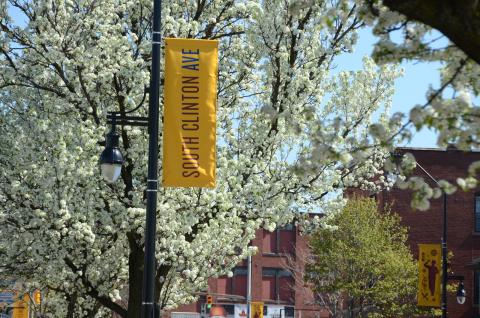City of Rochester Vacuum Oil Brownfield Opportunity Area (BOA)
Project Background
The New York State Department of State’s Brownfield Opportunity Areas (BOA) Program provides communities with guidance, expertise and financial assistance to complete revitalization and implementation strategies for neighborhoods or areas affected by brownfields. The NYS BOA Program enables communities to assess existing economic and environmental conditions associated with areas impacted by brownfields, and more importantly, develop a plan to identify specific projects and strategies to support and incentivize public and private sector investment. The primary objective of the process is to assist communities that have been negatively impacted by the presence, or perceived presence, of environmentally sensitive sites, such as parcels impacted by the former Vacuum Oil refinery.
The BOA program originated as a three-step process:
- Step 1 (Pre-Nomination phase): Information gathering and eligibility
- Step 2 (Nomination phase): Detailed analysis of existing conditions and visioning
- Step 3 (Implementation phase):Redevelopment plan refinement and completion of activities to support future implementation
Vacuum Oil BOA Site Background & History
A significant portion of the Vacuum Oil BOA was part of the former Vacuum Oil refinery, bulk oil storage, and oil blending facility which operated from about 1866 to about 1935 on approximately 30 to 40 acres of land east of Exchange Street and both north and south of Flint Street. Other historical uses include railroads and canals for the shipment of crude oil and finished petroleum products. Up until 1890, the primary raw material used at the Vacuum Oil Works was crude oil, which was used in the preparation of finished lubricant products. Vacuum Oil began receiving crude oil in wooden barrels from Pennsylvania in 1869, and it was estimated that by 1887 Vacuum Oil processed over 4 million gallons of crude oil per year (Wagner, 1990). Portions of the former Vacuum Oil refinery were subsequently used for other various industrial and commercial uses, while other portions south of Flint Street remained vacant land or underutilized. The Vacuum Oil Company was a predecessor of the ExxonMobil Corporation.
In 1989, a tar-like substance was encountered on a property owned by New York State located immediately south of the former Vacuum Oil facility. New York State Department of Environmental Conservation (NYSDEC) excavated and properly disposed of the tar off-site. In 2001, NYSDEC completed a preliminary environmental investigation of a 24-acre portion of the former Vacuum Oil facility south of Flint Street. In 2005 and 2009, ExxonMobil evaluated historical and current site conditions, and completed a subsurface environmental investigation on a portion of the Site. In 2012, a Phase I Environmental Site Assessment report was prepared on behalf of the City of Rochester. Based on these previous studies and investigations, soil and groundwater on portions of the Site are contaminated primarily with volatile organic compounds or “VOCs”, semi-VOCs, metals and other contaminants.
The City of Rochester applied and was accepted into the Brownfield Cleanup Program (BCP) in April 2015 as a “Volunteer” under the BCP. Under an approved work plan, a comprehensive BCP Remedial Investigation was completed on 8 City-owned properties under technical oversight by both the NYSDEC and the New York State Department of Health (NYSDOH). Two other NYSDEC BCP projects are being performed by private owners and developers on sites within the Vacuum Oil BOA. The first BCP project is located at 5 Flint Street and 15 Flint Street properties (NYSDEC Site No. C828162), and the second BCP project is located at 936 Exchange Street and 22 Flint Street properties Site Code (C828193) which were also part of the former Vacuum Oil refinery site. Further information regarding these two other Brownfield Cleanup Program project sites can be found at the Phillis Wheatley Community Library (33 Dr. Samuel McCree Way) or by contacting the NYSDEC Region 8 Project Manager, Frank Sowers (phone: 585-226-5357).
Vacuum Oil BOA Step 1 and Step 2 – Pre-Nomination & Nomination Phases
In 2006, the City of Rochester completed a Pre-Nomination Study for the Vacuum Oil – South Genesee River Corridor, which encompassed a 58-acre study area. In 2006, the City of Rochester completed an initial inventory of existing conditions within the Vacuum Oil BOA, which allowed the City to apply for additional funding to move to Step 2 of the BOA program.
In the Step 2 Nomination Study (completed in April 2013), the Project Advisory Committee (PAC) and the City worked together to expand this boundary to include approximately 148 acres located along the Genesee River and Plymouth Avenue south of Center City Rochester and develop a revitalization strategy. The VOBOA is bounded by the Plymouth Avenue commercial corridor on the west, and includes components of the Plymouth-Exchange (PLEX) and South West Area Neighborhoods between Barton Street and Ford Street.
The Step 2 process in the Vacuum Oil BOA study area commenced in 2010. Over a three-year period, the City worked collaboratively with neighborhood stakeholders to identify the types of development and projects community members would like to see implemented within the neighborhood and along the riverfront. Key themes from stakeholders that were integrated into the plan included:
- better connectivity between existing residential areas and the riverfront;
- additional public spaces and amenities;
- environmental remediation of existing brownfield sites;
- celebrate unique history of the area;
- improve sense of safety and security; and
- provide more programming along the Genesee River.
In recognition of the work completed as part of Step 2, the City received top honors - the Outstanding Achievement Award – in 2014 from New Partners for Community Revitalization, which was the leading not-for-profit brownfields organization in the State at that time.
In addition, the Vacuum Oil Brownfield Opportunity Area was among the first of twelve BOAs designated by Governor Cuomo, making Vacuum Oil Brownfield Opportunity Area properties eligible for additional tax credit incentives to transform dormant and blighted areas into economic development projects.
In 2014, the City received a State grant award to advance to the Step 3, Implementation phase of the BOA program, which resulted in more detailed planning and the completion of a range of pre-development studies and activities to inform future implementation activities.
Vacuum Oil BOA Step 3 – Implementation
The vision for the Vacuum Oil BOA, as defined in Step 2, established a framework in which to identify additional studies and activities that should be undertaken to help advance and facilitate the neighborhood’s vision for their future. The studies and activities completed during the Vacuum Oil Step 3 process addressed the following general categories:
- Site specific market and economic analyses
- Engineering analyses
- Environmental assessment
- Natural resource inventories and assessments
- Design development for targeted redevelopment sites and areas
- Archaeological studies
- Land appraisals
- Geotechnical investigations
- Residential and housing strategies
- Waterfront master planning
The final Brownfield Opportunity Area document, as well as all supporting appendices, are available at the links below:
- Appendix 1 - Community Involvement Plan
- Appendix 2A - Project Advisory Committee (PAC) 1 Summary
- Appendix 2B - PAC 2 Summary
- Appendix 2C - PAC 3 Summary
- Appendix 2D - PAC 4 Summary
- Appendix 2E - PAC 5 Summary
- Appendix 2F - PAC 6 Summary
- Appendix 3A - PLEX Summary
- Appendix 3B - Public Workshop Summary
- Appendix 3C - Public Information Open House
- Appendix 3D - Public Workshop Transportation
- Appendix 4 - Wetland Assessment and Invasive Species Report
- Appendix 5 - Phase 1A Archaeological Sensitivity Assessment
- Appendix 6 - Housing Reinvestment Strategy
- Appendix 7 - Vacuum Oil Housing Analysis
- Appendix 8 - PLEX Redevelopment and Community Health Toolkit
- Appendix 9 - Traffic Analysis Report
- Appendix 10 - Wall Evaluation Report
- Appendix 11 - Parks and Open Space Master Plan
- Appendix 12 - Luther Circle Redevelopment Alternatives
- Appendix 13 - Neighborhood Redevelopment Strategies
- Appendix 14A - Residential Pro Forma Memo
- Appendix 14B - Residential Pro Forma
- Appendix 15 - 5 Flint Street Building Assessment Report
- Appendix 16A - Phase I ESA - 91 Violetta Street (file too large; unable to upload. Please email for more information.)
- Appendix 16B - Phase I ESA - 920 Exchange Street (file too large; unable to upload. Please email for more information.)
- Appendix 17 - Land Appraisal for 920 Exchange Street & 91 Violetta Street
- Appendix 18 - Geotechnical Analysis
In compliance with the New York State Environmental Quality Review law, the City prepared a Generic Environmental Impact Statement which includes a thorough analysis of various reuse alternatives within the Vacuum Oil BOA study area and identifies potential impacts and mitigation activities.
- The Draft Generic Environmental Impact Statement (DGEIS) was published on September 29, 2017.
- The Final Generic Environmental Impact Statement (FGEIS) was published on May 31, 2018.
Other Documents
- Vacuum Oil Preferred Parks, Open Space, Waterfront Concept Master Plan 2019
- Vacuum Oil BOA Supplemental, Grading, Utilities & Wetland Mitigation Report 04-30-19
- State Environmental Quality Review Act (SEQR) Lead Agency Findings Statement 05-31-18
Vacuum Oil BOA Community Participation
This community-based planning effort sought to integrate ideas generated from residents, business owners and other stakeholders into the development of plan recommendations. Continued involvement and participation by the public is critical to ensuring implementation of the BOA vision is achieved.
Over the course of the Step 2 and Step 3 planning processes, significant efforts were made to engage residents, property owners, business owners and other stakeholders with an interest in the future revitalization of the study area. During the planning period the following engagement activities occurred:
- 14 Project Advisory Committee (PAC) meetings. The PAC included widespread representation including state agencies, City staff, neighborhood organizations, residents, business owners and special interests.
- Over 40 Stakeholder meetings.
- 10 Public Informational Meetings and Design Workshops.
- 1 Joint Design Charrette with the PLEX Neighborhood organization.
Additional Questions
If you have any questions regarding the Vacuum Oil Site please contact Jane MH Forbes, Senior Environmental Specialist, at 585-428-7892 or email her at Jane.Forbes@cityofrochester.gov.






